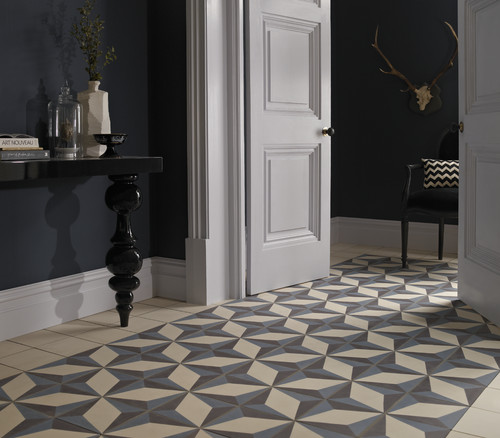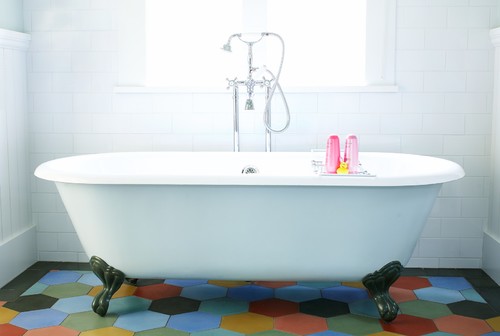Decorative Cement Tiles That Age With Grace
Posted by William Buyok on
Be floored by hand-crafted decorative cement tiles that will bring lasting beauty to your home
Avente Tile was featured in this article on Houzz, November 1, 2015. The author, Janet Dunn, is a Houzz and lifestyle magazine contributor, writer, stylist and interior design enthusiast. She spends time in two beautiful places: the Sunshine Coast and the Southern Highlands. She also edits and writes for Protect Wooli website.
The fascinating art of making cement tiles with multi-coloured inlaid designs has been around for hundreds of years. In many countries, they are often still hand-crafted in the time-honoured way using traditional patterns, but as newer designs are introduced, their popularity in modern homes is increasing. Be inspired by the versatility and dynamism of artisan-made tiles that may very well still be around long after your house is gone.
Tile Identity Crisis?
You'll often see the word encaustic applied to patterned multi-colored cement tiles. Historically, this term refers to a firing process that burns a glazed pattern onto the surface of a tile. But strangely, it has also been applied for a long time to cement tiles with a deep inlaid pattern, rather than a surface glaze, which are compressed to bind the pieces together, not fired.
In this process, mineral pigments are hand-poured into a design mould, the tile is back-filled with cement then set by hydraulic compression before curing. So although not strictly correct, the term encaustic is now widely accepted, even in the trade for these tiles. In this story, we're talking about hydraulically compressed cement tiles with a moulded pattern in the body of the tile.
Inlaid patterned cement tiles are found world-wide. The art form survives in France, Spain, Italy, Turkey, Mexico, Latin America and Scandinavia, although composition and designs vary with cultural influences. Imported tiles influenced by the Mediterranean were all the rage in Victorian England for a time. Cuba adapted the process from Spain and Havana's gently decaying colonial buildings are famous for their lovely time-worn, tiled floors. Vietnam, where examples of decorative cement tiles are found in 18th century pagodas and churches, also has a thriving tile industry today.
Why Cement Tiles?
Georgia Ezra, director and creator of Tiles of Ezra, says there is lots to love about these decorative tiles. "They are an incredibly versatile product and are not just for indoor floors," she says. "Courtyards, pathways, bathroom walls, splashbacks [backsplashes], entrances, anywhere you use them they'll really make an impact."
As well as keeping artisan crafts alive and providing commercial opportunities in less affluent countries, there are also some environmental payoffs in handmade cement tiles. They use earth-based components, natural pigments and consume less energy than fired tiles.
Work patterned tiles into your kitchen
A major drawcard for Ezra, however, is their perfect imperfection. Thickness can vary slightly from tile to tile, as can pigment shadings, and patterns may bleed at the edges when compressed, all enhancing their uniqueness. "What I love about them is their lack of uniformity," she says. "They don't look mass-produced because hand-pouring the pigments that form the design means every tile is slightly different. This inconsistency adds to their beauty and interest."
Another reason for their attraction is that they are a living tile that changes over time. Ezra says, although some may consider this a disadvantage and prefer a tile that stays bright and new-looking, the mellowness of a tile that ages gracefully is what makes them special. "If you dont want the safe option of a mass-produced, unchanging tile with no maintenance needs, they are a dynamic and personalized choice," she says. "An attractive patina is more likely to develop outside, with exposure to wind, water and sun, or in high traffic areas."
Ezra says that, compared to other quality tiles, the cost for such a distinctive product is moderate, ranging from $150 to $350 a square meter. Because they can make such an impact as a feature tile for a small area, they give a lot of value for a modest outlay. Pathway edges, courtyard wall panels, benchtops, stair risers, outdoor tabletops or, as seen here, a neat kitchen splashback, are just some of the ways that a small quantity of patterned tiles can bring big design returns.
Decorative Cement Tiles in Modern Decor
There are many reasons why these tiles work well in today's homes.
Featureless becomes fun
With many homeowners preferring low-maintenance materials and super-efficient interior design, especially in functional areas, these spaces can look a little clinical. Swap the laboratory look of a monochrome kitchen for a warm and inviting space with the natural textures and colors of a hard-wearing patterned cement tile floor.
And as a bonus, patterned tiles hide crumbs! Perfect choice for the kitchen.
This pure white bathroom is saved from basic by just a small injection of luxuriously intricate patterned tiles in deep mulberry pink (and a pink rubber ducky). There is hint of Marrakesh in the classic lantern shape of the mirror, a traditional Moroccan motif.
Bring modern Mediterranean style to your bathroom
They Create Decor Diversity
It's easy to coordinate a color scheme for a room that features a multi-colored floor tile. Rather than restricting options, it opens up a whole range - just carry two or three of the tile colors around the room in furniture, artwork and accessories, and the room will fall into place with minimal effort.
Changing the direction of the decor is easy too. By pulling out one color in the tile and amping up that color in the rest of the room, you can achieve many different looks.
Patterned concrete tiles cover all decor bases. While some patterns are soft and understated, with elegant geometrics and curves, others just want to have fun. Like the lively stylized flowers on this very jazzy bathroom floor.
More feature floor tile ideas for the bathroom
As well as creating contrast with smooth engineered modern surfaces, handmade cement tiles are a perfect partner for natural materials like rustic waxed timber, stone and aged metal finishes. Their patina and slight imperfections work well with vintage and industrial elements.
You Can Please Yourself
With the almost endless combinations possible with patterned cement tiles, you can choose your own adventure when it comes to the design. Be your own tile artist and design a unique feature. By picking complementary colors and a mixture of plains and patterns, your floors and walls will be completely unique. Some manufacturers will even custom-design a tile just for you.
See how to mix and match tiles in the bathroom
If you're pattern-shy but want a bold punch of color, go for monochrome cement tiles with a deeply inlaid pigment layer, a handmade artisan look and slight surface variations. Choose your color combination and play jigsaw puzzles for a one-of-a-kind feature. Plain tiles will have slight tone variations and shadowing, which just adds to their character, says Ezra. Randomly-laid, bright, six-sided shapes make for a fresh and playful floor in this bathroom, alongside a traditional clawfoot bath and tap assembly.
Patterned Tiles Are at Home with Any Style
Victorian English homes, with their somewhat ornate decorative leanings, embraced the patterned cement tile and it subsequently made its way to the Antipodes. Paths, verandas, entrances and hallways in many early Victorian and Federation Australian homes often retain tiled areas with plain or contrasting borders, and complement period features like decorative brickwork, mouldings, stained glass, wall panels and archways.
From Federation to funky: if your home style is eclectic, ignore the rules and jumble up patterns for a look that is uniquely and boldly you, as in this Barcelona study. Many cement tiles are made in quartets that fit together to make a symmetrical design, as on this floor. But they can be laid randomly for a more free-and-easy look too.
Spacious, modern, open-plan homes are well suited to patterned tile features as well. A bold geometric accent wall, which would overpower an enclosed space, is shown to advantage in an openly flowing one. And it can be appreciated from several angles around the space.
Tough, With a Little TLC
"Cement tiles are hard-wearing after all, they've survived all over the world for centuries," says Ezra. "But the secrets in the sealing. It's a porous tile and needs annual sealing. If left 'raw', it's susceptible to staining."
Be prepared for some maintenance. In wet areas, the membrane must be completely waterproofed prior to installation and sealed once installed. Sealing tiles once a year may be not be convenient for some homeowners, who may prefer a non-porous (or vitreous) tile. Ezra recommends that the slip rating be confirmed with the supplier before laying in wet areas.
Because of their handmade nature, these tiles are not a DIY project and should be professionally laid. Ensure your tiling professional is familiar with the tiles properties and the care required in their installation.
If you're seduced by the design possibilities of patterned cement tiles, be aware of their special qualities. Ezra advises that they need maintenance, but not pampering. "All that beauty and uniqueness comes with a little upkeep, but it's well worth it," she says.
Share this post
- Tags: Cement Tile, Custom Tile, Floor, Tile Care, Tile Design, Tile Maintenance




















